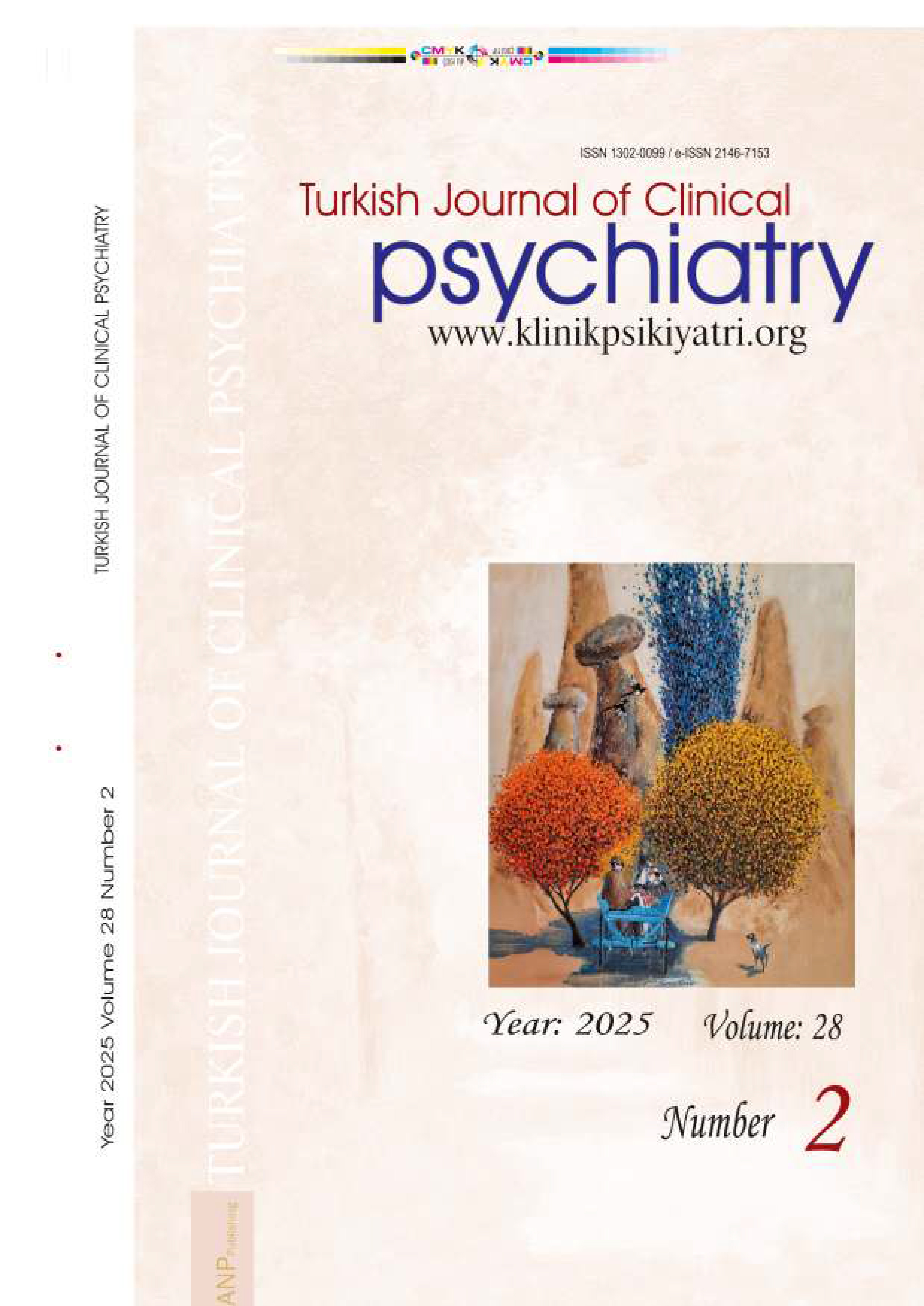





Volume: 5 Issue: 1 - 2002
| RESEARCH ARTICLE | |
| 1. | Risk Factors in Depressive Disorders Süheyla Ünal, Levent KÜEY, Cengiz Güleç, Mehmet BEKAROGLU, Yunus Emre EVLİCE, Selçuk KIRLI Pages 8 - 15 Some risk factors such as sex, family history, stressful life events, disappointments, family dysfunction, poor parental care, early adversity, and personality traits such as dependent and obsessive, insecure attachment style, chronic psychiatric or medical diseases, lack of social support precede the onset of depression and also affect the outcome of depression. The aim of this study is to investigate the incidence of risk factors preceding the onset of depression in outpatient psychiatric population. The data were collected from 2014 depressive patients evaluated by approximately 500 psychiatrists, all over Turkey between 1994-1995. In this study depressive patients were evaluated with DSM-lll-R, Sociodemographic data form. Psychosocial Stress Factors Inventory (according to DSM-lll-R) and Hamilton Depression Inventory. Statistical analyses have been carried out by means of standard programmes according to SPSS-PC, using chi-square test. In our study, having a positive family history of mood disorder, being female and being old between 25-44 age were reported as risk factors. Also, 17.5% of patients declared psychiatric disease history in family member and 35% of patients reported previous depression. Whereas female patients has more chronic medical illness, male patients has more drug abuse and addiction problems. Reported life events were 1534 (76%). We found similar frequency and severity of life events in depressed females and males. Females mostly reported marital problems, and female to male interpersonal problems, whereas males reported upon job and interpersonal problems. A lot of risk factors such as biologic vulnerability, gender, age, stressful life events, medical illness have an important precipitating role in the genesis of depression. |
| 2. | Stuttering in Children: A Comprehensive Study Ayşe AVCI, Şükrü UGUZ, Fevziye Toros Pages 16 - 21 dal stress factors, having obsessive personality or low-selfesteem, central nervous system anomalities, being first child in family are risk factors. In this study we aimed; first, to understand sociodemographic pattern of the patients with stuttering, second, to evaluate the features of psychosocial stress factors and to find the sociodemographic differences between recovered and unrecovered groups. 188 children/adolescents with stuttering referred to the departments of child and adolescent psychiatry were enrolled this study. 83 of all children with stuttering were interviewed again, and 43 of this have not have stuttering for 6 months (Group 1). 40 of this cases have stuttering (Group 2). Group 1 was earlier referral at department of child and adolescent psychiatry than Group 2. The onset time of starting speak with sentences using three words was earlier in Group I. There was much more stress factors before begining of stuttering in Group 1. |
| 3. | Axis I and Axis II Diagnoses in Suicide Attempters Figen Çulha ATEŞÇİ, Murat Kuloğlu, Mustafa YILDIZ Pages 22 - 27 noses in a group of suicide attempters. The study group was consisted of 60 adult patients who had been consulted for suicide attempt in the emergency department of the Medical School of the University of Fırat, between February 1996 and January 1997. Patients were evaluated SCID I and SCID II forms for the DSM-IITR following the interview. 46.6% of the patients had depressive spectrum diagnoses (18.3% major depressive disorder, 15% depressive disorder NOS, 13.3% dysthymia). Meanwhile, 18.3% was diagnosed as having borderline personality disorder, and 16.7% histrionic personality disorder. No major mental disorder in 15%, and no personality disorder in 51.7% was diagnosed. In this study, it was found that, depressive disorders were the most frequently seen mental disorder among the suicide attempters, and borderline personality and histrionic personality disorders were the most common comorbid personality disorders in these patients. |
| 4. | Serum Cholesterol Levels in Patients with Violent and non-violent Suicide Attempters Murad ATMACA, Murat Kuloğlu, Ertan TEZCAN, Ayten BÜYÜKBAYRAM Pages 28 - 32 The association between low or lowered cholesterol through treatment and impulsivity, aggressive behaviors and suicide attempts has been focused on for a long period. In the present study, cholesterol levels of the patients with violent and nonviolent suicide attempt have been compared with healthy controls. The study was carried out in Firat University School of Medicine Emergency Unit and Department of Psychiatry between May- August 2001. The study was consisted of 26 violent suicide attempters and 26 healthy controls who had applied to the same center because of routine driving license examination. The clinical evaluation was performed by a trained psychiatrist within 48 hours following admission. A semi-structured clinical interview was carried out to establish DSM-IV diagnoses. On the other hand, serum total cholesterol levels were detected. The mean cholesterol level of the patients was significantly lower than that of controls. The difference was more significant in the patients with violent suicide attempt compared to those with non-violent suicide attempt. The studies with large sample that try to decipher which dimension/dimensions of suicide attempts could account for this relationship are required. |
| REVIEW | |
| 5. | A Review for Valproate use in Psychiatric Disorders Tuncer Okay, Cebrail KISA, Nesrin DİLBAZ Pages 33 - 41 The valproate which had been started to use as anticonvulsant after years of its discovery has also been started to use in the treatment for bipolar disorder. Today, it has been used also in dementia, posttraumatic stress disorder, personality disorder, tardive dyskinesia, alcohol dependency and withdrawal, psychotic disorder, major depressive disorder, anxiety disorders and in the other organic and functional psychiatric statements which progress with impulsive severe behaviors. It acts effectively in affective disorders, anxiety disorders, the statements as impulsive disorders and agitation especially. The literature related with valproate use for psychiatric statements -in symptom and disorders- has been reviewed in this paper. |
| 6. | Relapse in Alcohol Dependency Zuhal DOGRUER, Hakan Türkçapar, Ahmet İNCE Pages 43 - 49 One of the most important characteristics of the alcohol dependency is its chronic and relapsing nature. Various models have been proposed to account for this phenomenon. The accurate prediction of which alcoholic patients would relapse concerns both clinicians and researchers. In this review the proposed relapse models and the factors predicting relapse were discussed by reviewing the related literature. As a result what was observed is that the patients who relapse and who do not differ in terms of biological, psychological and social characteristics. |
| CASE REPORT | |
| 7. | Isolated Angiitis of the Central Nervous System: A Case Report with Atypical Psychiatric Symptoms Çiçek Hocaoğlu, Meliha TAN Pages 50 - 55 Isolated angiitis of the central nervous system (IACNS) is a rare form of angiitis limited to the central nervous system. The clinical finding of the combined series revealed that headache was the most common symptom with a combination of focal and diffuse neurological deficits. The case, a 28- year- old man, is present- ed;the clinical presentation and diagnostic difficulties are discussed. Patient's symptoms begun with an obvious atypical depression. In spite of an antidepressive treatment, his symptoms continued, being relatively worse; personality and mood changes added to the clinical picture. Meanwhile several transient ischemic attacks, six monts later, he was admitted with neurological symptoms including headache, diplopia, and cerebellar ataxia. The radiological investigation was mimicked by primary brain lymphoma. The brain biopsy excluding of lymphoma revealed parenchymal hemorrhage with nonspecific degenerative changes. In systemic investigation, any underlying cause for vasculitis could not be found. Neurological but not psychic findings and radiological lesions of the patient ameliorated with steroid theraphy. Since we could not find features of systemic vasculitis, the patient's lesions responded to corticostreoid treatment and neuropathological investigation revealed no lymphoma. We concluded that the most probable diagnosis would be IACNS. |










